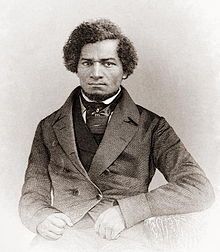A mojo, in the African-American spiritual practice called Hoodoo, is an amulet consisting of a flannel bag containing one or more magical items. It is a "prayer in a bag", or a spell that can be carried with or on the host's body. Alternative American names for the mojo bag include gris-gris bag, hand, mojo hand, toby, nation sack,conjure hand, lucky hand, conjure bag, juju bag, trick bag, tricken bag, root bag, and jomo. The word mojo also refers to magic and charms. Mojo containers are bags, gourds, bottles, shells, and other containers. The making of mojo bags in Hoodoo is a system of African-American occult magic. The creation of mojo bags is an esoteric system that involves sometimes housing spirits inside of bags for either protection, healing, or harm and to consult with spirits. Other times mojo bags are created to manifest results in a person's life such as good-luck, money or love.

Zora Neale Hurston was an American author, anthropologist, and documentary filmmaker. She portrayed racial struggles in the early-20th-century American South and published research on hoodoo and Caribbean Vodou. The most popular of her four novels is Their Eyes Were Watching God, published in 1937. She also wrote more than 50 short stories, plays, and essays.
In folklore, crossroads may represent a location "between the worlds" and, as such, a site where supernatural spirits can be contacted and paranormal events can take place. Symbolically, it can mean a locality where two realms touch and therefore represents liminality, a place literally "neither here nor there", "betwixt and between".
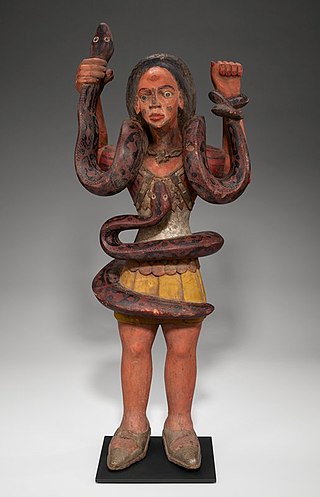
A Simbi is a water and nature spirit in traditional Kongo spirituality, as well as in Hoodoo.

Hoodoo is a set of spiritual practices, traditions, and beliefs that were created by enslaved African Americans in the Southern United States from various traditional African spiritualities and elements of indigenous botanical knowledge. Practitioners of Hoodoo are called rootworkers, conjure doctors, conjure men or conjure women, and root doctors. Regional synonyms for Hoodoo include rootwork and conjure. As a syncretic spiritual system, it also incorporates beliefs from Islam brought over by enslaved West African Muslims, and Spiritualism. Scholars define Hoodoo as a folk religion. It is a syncretic religion between two or more cultural religions, in this case being African indigenous spirituality and Abrahamic religion.

Their Eyes Were Watching God is a 1937 novel by American writer Zora Neale Hurston. It is considered a classic of the Harlem Renaissance, and Hurston's best known work. The novel explores protagonist Janie Crawford's "ripening from a vibrant, but voiceless, teenage girl into a woman with her finger on the trigger of her own destiny".
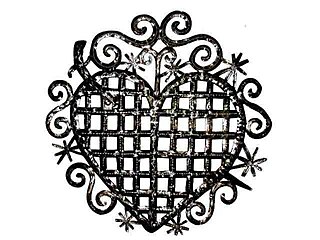
Èzili Dantò or Erzulie Dantor is the main loa or senior spirit of the Petro family in Haitian Vodou. Ezili Danto, or Èzili Dantò, is the "manifestation of Erzulie, the divinity of love." It is said that Ezili Danto has a dark complexion and is maternal in nature. The Ezili are feminine spirits in Haitian Vodou that personify womanhood. The Erzulie is a goddess, spirit, or loa of love in Haitian Voudou. She has several manifestations or incarnations, but most prominent and well-known manifestations are Lasirenn, Erzulie Freda, and Erzulie Dantor. There are spelling variations of Erzulie, the other being Ezili. They are English interpretations of a Creole word, but do not differ in meaning.
A black cat bone is a type of lucky charm used in the magical tradition of hoodoo. It is thought to ensure a variety of positive effects, such as invisibility, good luck, protection from malevolent magic, rebirth after death, and romantic success.
...Got a black cat bone
got a mojo too,
I got John the Conqueror root,
I'm gonna mess with you...
African-American folktales are the storytelling and oral history of enslaved African Americans during the 1700s-1900s. Prevalent themes in African-American folktales include tricksters, life lessons, heartwarming tales, and slavery. African Americans created folktales that spoke about the hardships of slavery and told stories of folk spirits that could outwit their slaveholders and defeat their enemies. These folk stories gave hope to enslaved people that folk spirits would liberate them from slavery. However, sometimes these folktales would be used to perpetuate negative stereotypes about the African American community. As seen in Song of the South, African American folklore written by the whiet community during 18th century can be used to maintain these views. One of these heroes that they looked up to was the charming High John the Conqueror, who was a cunning trickster against his slave masters. He often empowered newly freed slaves, saying that if they needed him, his spirit would be in a local root. Other common figures in African-American folktales include Anansi, Brer Rabbit, and Uncle Monday. Many folktales are unique to African-American culture, while others are influenced by African, European, and Native American tales. Even today in Hip-Hop, we see the effects of African American Folklore. Tropes like Badman and Trickster have influenced the tropes and themes seen in modern day hip hop like gangsters and pimps.
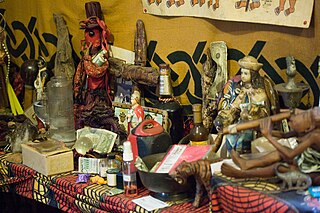
Louisiana Voodoo, also known as New Orleans Voodoo, is an African diasporic religion that originated in Louisiana. It arose through a process of syncretism between the traditional religions of West Africa, the Roman Catholic form of Christianity, and Haitian Vodou. No central authority is in control of Louisiana Voodoo, which is organized through autonomous groups.

Cudjoe Kazoola Lewis, born Oluale Kossola, and also known as Cudjo Lewis, was the third to last adult survivor of the Atlantic slave trade between Africa and the United States. Together with 115 other African captives, he was brought to the United States on board the ship Clotilda in 1860. The captives were landed in backwaters of the Mobile River near Mobile, Alabama, and hidden from authorities. The ship was scuttled to evade discovery, and remained undiscovered until May 2019.

Africatown, also known as AfricaTown USA and Plateau, is a historic community located three miles (5 km) north of downtown Mobile, Alabama. It was formed by a group of 32 West Africans, who in 1860 were bought and transported against their will in the last known illegal shipment of slaves to the United States. The Atlantic slave trade had been banned since 1808, but 110 slaves held by the Kingdom of Dahomey were smuggled into Mobile on the Clotilda, which was burned and scuttled to try to conceal its illicit cargo. More than 30 of these people, believed to be ethnic Yoruba, Ewe, and Fon, founded and created their own community in what became Africatown. They retained their West African customs and language into the 1950s, while their children and some elders also learned English. Cudjo Kazoola Lewis, a founder of Africatown, lived until 1935 and was long thought to be the last survivor of the slaves from the Clotilda living in Africatown.

Invisible churches among enslaved African Americans in the United States were informal Christian groups where enslaved people listened to preachers that they chose without their slaveholder's knowledge. The Invisible churches taught a different message from white-controlled churches and did not emphasize obedience to slave masters. Some slaves could not contact invisible churches and others did not agree with an invisible church's message but many slaves were comforted by the invisible churches.

A barracoon is a type of barracks used historically for the internment of enslaved or criminal human beings.
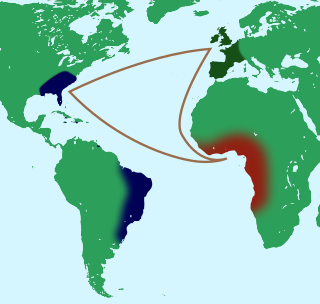
Flying Africans are figures of African diaspora legend who escape enslavement by a magical passage back over the ocean. Most noted in Gullah culture, they also occur in wider African-American folklore, and in that of some Afro-Caribbean peoples.
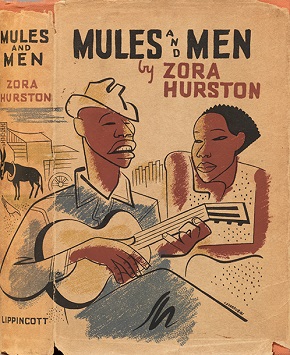
Mules and Men is a 1935 autoethnographical collection of African-American folklore collected and written by anthropologist Zora Neale Hurston. The book explores stories she collected in two trips: one in Eatonville and Polk County, Florida, and one in New Orleans. Hurston's decision to focus her research on Florida came from a desire to record the cross-section of black traditions in the state. In her introduction to Mules and Men, she wrote, "Florida is a place that draws people—white people from all over the world, and Negroes from every Southern state surely and some from the North and West". Hurston documented 70 folktales during the Florida trip, while the New Orleans trip yielded a number of stories about Marie Laveau, voodoo and Hoodoo traditions. Many of the folktales are told in vernacular; recording the dialect and diction of the Black communities Hurston studied.
Jonah's Gourd Vine is Zora Neale Hurston's 1934 debut novel. The novel is a semi-autobiographical novel following John Buddy Pearson and his wife, Lucy. The characters share the same first names as Hurston's parents and make a similar migration from Notasulga, Alabama to Hurston's childhood home, Eatonville, Florida.
Moses, Man of the Mountain is a 1939 novel by African-American novelist and anthropologist Zora Neale Hurston. The novel rewrites the story of the Book of Exodus of Moses and the Israelites from an Afro-American perspective. The novel applies a number of different motifs and themes commonly addressed in African-American culture, subverting the Moses story.

Barracoon: The Story of the Last "Black Cargo" is a non-fiction work by Zora Neale Hurston. It is based on her interviews in 1927 with Oluale Kossola who was presumed to be the last survivor of the Middle Passage. Two female survivors were subsequently recognized but Cudjoe continued to be identified as the last living person with clear memories of life in Africa before passage and enslavement.
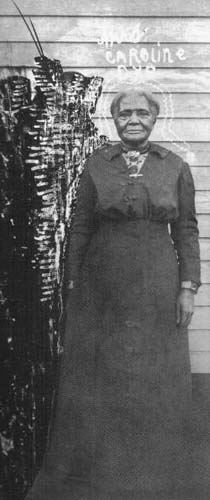
Caroline Dye also known as Aunt Caroline, was a renowned African American Hoodoo woman, rental property investor, soothsayer, rootworker and conjuror based in Newport, Arkansas.

